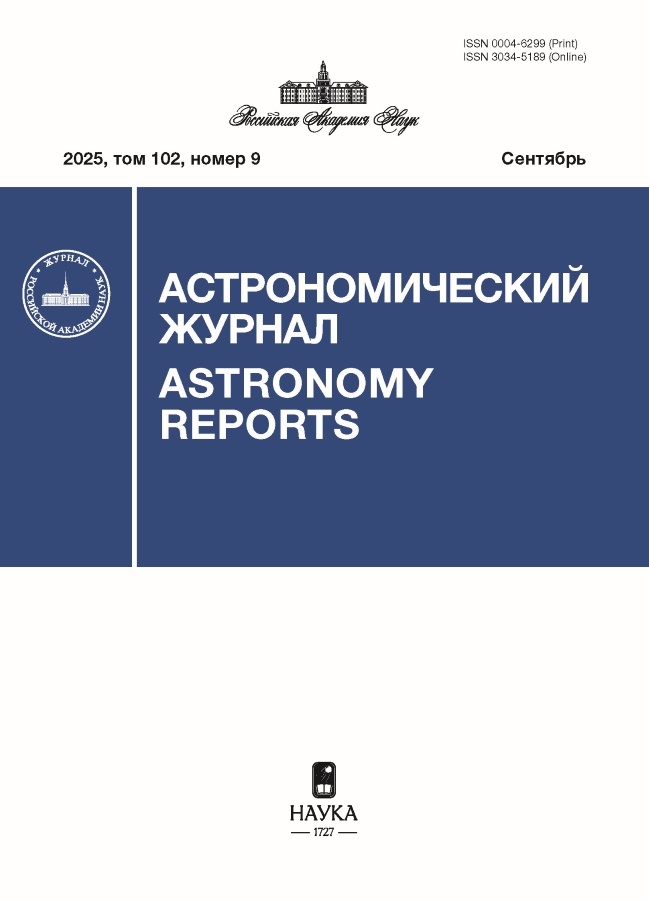The Probable Quadruple Systems GI CEP and V548 CYG
- 作者: Khaliullina A.I.1
-
隶属关系:
- Sternberg State Astronomical Institute, Lomonosov Moscow State University
- 期: 卷 102, 编号 9 (2025)
- 页面: 780-789
- 栏目: Articles
- URL: https://vietnamjournal.ru/0004-6299/article/view/695912
- DOI: https://doi.org/10.31857/S0004629925090042
- ID: 695912
如何引用文章
详细
Orbital-period variations of the eclipsing binaries GI Cep and V548 Cyg are analyzed. The period variations in both systems can be described as a superposition of secular decrease and two cyclic variations of the period. The rate of decrease of the period dP/dt = 3.73 · 10–7 day/year for GI Cep and 2.38 · 10–7 day/year for V548 Cyg. A superposition of two kinds of cyclic variations is observed for GI Cep and V548 Cyg: with periods of 14.4 years and 33.7 years for GI Cep, and 5.4 and 43.8 years for V548 Cyg. The observed cyclic variations in the period of GI Cep can occur due to the presence of a third body in the system or due to the magnetic activity of the secondary component. The system can be triple or quadruple. The hypothesis of magnetic activity is not suitable for V548 Cyg. Apparently, this is quadruple system.
作者简介
A. Khaliullina
Sternberg State Astronomical Institute, Lomonosov Moscow State University
Email: hfh@sai.msu.ru
Moscow, Russia
参考
- P. Parenago, Переменные звезды 5, 206 (1938).
- G. Romano, Mem. Soc. Astron. Ital. 33, 363 (1962).
- M.A. Svechnikov, Eh.F. Kuznetsova, Vizier On-line Data Catalog: Approximate elements of eclipsing binaries (1990).
- B. Apak, A. Erdem, O. Öztürk, M.I. Gözütok, and D. Sürgit, AIP Conf. Proc. 2042, № 1 (2018).
- C. Hoffmeister, Erg. Astron. Nachr. 12, № 1 (1949).
- Т.А. Азарнова, Переменные звезды 9, 40 (1951).
- P. Ahnert, Mitt. Veränder. Sterne 1, № 162 (1953).
- A. Fresa, Mem. Soc. Astron. Ital. 27, 51 (1956).
- M. Rodono, Mem. Soc. Astron. Ital. 38, 465 (1967).
- F. Mardirossian, M. Mezzetti, B. Cester, G. Giuricin, and G. Russo, Astron. and Aph. Suppl. Ser. 39, 35 (1980).
- A.Y. Ertan, Astrophys. and Space Sci. 77, 391 (1981).
- G. Russo, and L. Milano, Acta Astron. 33, 163 (1983).
- J.F. Heard and D.C. Morton, Astron. J. 61, 179 (1956).
- J.F. Heard and D.C. Morton, Publ. David Dunlap Obs. 2, 255 (1962).
- L.-Y. Zhu, X. Zhou, J.-Y. Hu, S.-B. Qian, L.-J. Li, W.-P. Liao, X.-M. Tian, and Z.-H. Wang, Astron. J. 151, 107 (2016).
- Yuan-Gui Yang, Chao Wu, W. Van Hamme, J.-Y. Hu, and J-Y. Wei, Astron. J. 152, 49 (2016).
- B. R. N. O. Project-Eclipsing Binaries database, http://var2.astro.cz/EN/brno/index.php.
- А.И. Халиуллина и Х.Ф. Халиуллин, Астрон. журн. 61, 393 (1984).
- Д.Я. Мартынов, в кн. М.С. Зверев, Б.В. Кукаркин, Д.Я. Мартынов, П.П. Паренаго, Н.Ф. Флоря и В.П. Цесевич, Переменные звезды, т. 3, Гостехиздат (1947), стр. 464–490.
- Х.Ф. Халиуллин, Астрон. журн. 51, 395 (1974).
- N. Ivanova and R.E. Taam, Astrophys. J. 599, 516 (2003).
- N. Nanouris, A. Kalimeris, E. Antonopolou, and H. Rovithis-Livaniou, Astron. and Astrophys. 535, 126 (2011).
- J.H. Applegate, Astrophys. J. 385, 621 (1992).
- Z. Eker, F. Soudugan, E. Soydugan, S. Bilir, E. Yaz Gökçe, I. Steer, M. Tüysüz, T. Şenyüz, and O. Demircan, Astron. J. 149, 131 (2015).
补充文件









